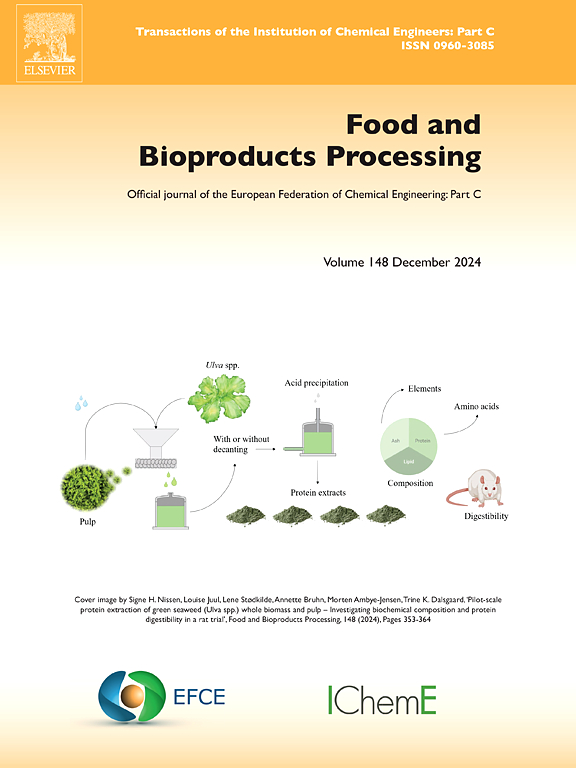Pilot scale succinic acid production from fibre sludge followed by the downstream processing
IF 3.5
2区 农林科学
Q2 BIOTECHNOLOGY & APPLIED MICROBIOLOGY
引用次数: 0
Abstract
The utilization of a cheap side stream is the core for biotechnological production of platform chemicals, such as, succinic acid. This study explores lab and pilot scale fermentation of Actinobacillus succinogenes (B1) and Basfia succiniciproducens (B2) to produce succinic acid from sulphide fibre sludge, a side product from pulp and paper industry. Both strains demonstrated efficient SA production, with lag phase of 2–3 h, accompanied by by-product formation of formic acid (FA) and acetic acid (AA). B1 outperformed B2 in SA concentration (28.4 g∙L-1 vs 20.4 g∙L-1) and yield ( 0.76 g·g-1 and 0.51 g·g-1), leading to its selection for pilot scale fermentations. Pilot scale fermentations using SFS hydrolysate as carbon source achieved SA yields of 0.62–0.66 g/g with productivities of 0.65 – 0.78 g∙L-1 SA. SFS hydrolysate, rich in glucose provided a promising substrate, yielding 23 g∙L-1 SA. Two downstream processing (DSP) methds were evaluated for SA recovery. DSP 1, involving microfiltration, electrodialysis, and ion exchange, achieved 62 % recovery but incurred losses during filtration and electrodialysis. DSP2 utilized activated carbon for decolorization, followed by microfiltration and crystallization, yielding 60.3 % SA recovery. Both DSP approaches produced high purity SA suitable for polymer applications. These results underscore the potential of SFS hydrolysate for sustainable SA production and highlight the need for process optimization, including fed-batch or continuous systems, to enhance yields and reduce costs. These findings contribute to advancing biobased monomer production as a viable alternative to fossil-based methods.
纤维污泥中试生产琥珀酸,然后进行下游处理
利用廉价的侧流是生物技术生产平台化学品(如琥珀酸)的核心。本研究探索了实验室和中试规模的琥珀酸放线菌(B1)和琥珀酸Basfia (B2)的发酵,从硫酸盐纤维污泥中生产琥珀酸,这是纸浆和造纸工业的副产品。两株菌株均能高效产SA,滞后期为2 ~ 3 h,并伴有甲酸(FA)和乙酸(AA)的生成。B1在SA浓度(28.4 g∙L-1 vs 20.4 g∙L-1)和产量(0.76 g·g-1和0.51 g·g-1)方面优于B2,因此被选择用于中试验规模发酵。以SFS水解液为碳源进行中试规模发酵,SA产率为0.62-0.66 g/g,产率为0.65 - 0.78 g∙L-1 SA。富含葡萄糖的SFS水解液提供了很有前途的底物,产23 g∙L-1 SA。评估了两种下游处理(DSP)方法对SA恢复的影响。采用微滤、电渗析和离子交换的DSP 1,回收率达到62% %,但在过滤和电渗析过程中损失较大。DSP2采用活性炭进行脱色、微滤和结晶,SA回收率为60.3 %。两种DSP方法都产生了适合聚合物应用的高纯度SA。这些结果强调了SFS水解物可持续SA生产的潜力,并强调了工艺优化的必要性,包括进料批次或连续系统,以提高产量和降低成本。这些发现有助于推动生物基单体生产作为化石基方法的可行替代方案。
本文章由计算机程序翻译,如有差异,请以英文原文为准。
求助全文
约1分钟内获得全文
求助全文
来源期刊

Food and Bioproducts Processing
工程技术-工程:化工
CiteScore
9.70
自引率
4.30%
发文量
115
审稿时长
24 days
期刊介绍:
Official Journal of the European Federation of Chemical Engineering:
Part C
FBP aims to be the principal international journal for publication of high quality, original papers in the branches of engineering and science dedicated to the safe processing of biological products. It is the only journal to exploit the synergy between biotechnology, bioprocessing and food engineering.
Papers showing how research results can be used in engineering design, and accounts of experimental or theoretical research work bringing new perspectives to established principles, highlighting unsolved problems or indicating directions for future research, are particularly welcome. Contributions that deal with new developments in equipment or processes and that can be given quantitative expression are encouraged. The journal is especially interested in papers that extend the boundaries of food and bioproducts processing.
The journal has a strong emphasis on the interface between engineering and food or bioproducts. Papers that are not likely to be published are those:
• Primarily concerned with food formulation
• That use experimental design techniques to obtain response surfaces but gain little insight from them
• That are empirical and ignore established mechanistic models, e.g., empirical drying curves
• That are primarily concerned about sensory evaluation and colour
• Concern the extraction, encapsulation and/or antioxidant activity of a specific biological material without providing insight that could be applied to a similar but different material,
• Containing only chemical analyses of biological materials.
 求助内容:
求助内容: 应助结果提醒方式:
应助结果提醒方式:


